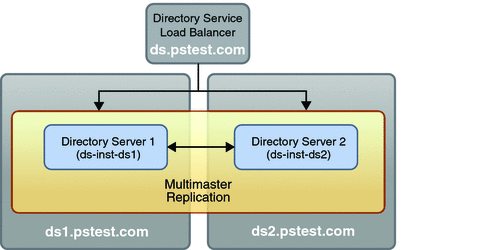Overview of the Directory Service Module
The directory service module of the reference configuration's deployment architecture illustrated in Figure 2–2 consists of two instances of Sun Java System Directory Server running on two different computers. The module makes use of a hardware load balancer that is configured to provide service failover capability between the two Directory Server instances. All requests for directory services are addressed to the virtual service name and IP address of the load balancer. The load balancer then directs each request to one of the two Directory Server instances.
In this module, the two Directory Server instances use multimaster replication to synchronize their data and to provide for a highly available directory service.
The architecture of the directory service module is shown in the following illustration.
Figure 4–1 Directory Service Module

When implementing the directory service module, you set up the Directory Server instances on ds1 and ds2. However, you do not implement multimaster replication until after you have installed and configured all of the other components in the reference configuration. The process of installing and configuring the other components writes configuration data to the directory, and in some cases will extend the schema. It is is easier to ensure that the directory is updated correctly if the configuration data and schema extensions are written to a single Directory Server instance. The data is replicated on the other Directory Server instance only after such configuration is complete.
Note –
The procedures in this chapter use the host names, domain name, and IP addresses shown in Figure 3–1 and Figure 4–1. However, you must map these host names, domain name, and IP addresses to equivalent names and addresses in your environment. For this reason, the procedures in this chapter show host names, domain name, and IP addresses as variables.
- © 2010, Oracle Corporation and/or its affiliates
